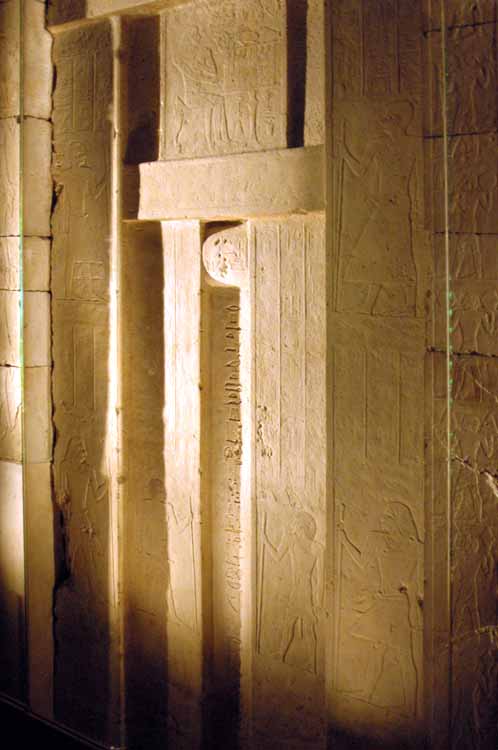
The tomb chapel of Raemkai was originally built at Saqqara (north of the step pyramid) and decorated for Neferiretenes and dates from the 5th Dynasty, in the Old Kingdom, during the reign of King Nyuserra (2445-2421 BC).
Neferiretenes, the original owner, held a number of titles and administrative offices. the reused of the tomb was probably by royal decree. We can surmise that Neferiretenes ("what she his mother has done good") either fell into disgrace or his family had died out leaving no one to care for his tomb.
Raemkai usurped the tomb, without changing the reliefs before the reign of Unas (2375-2345 BC). The inscriptions call Raemkai (his name means "the sun is my life force") "king's bodily son", and he may have been a true prince - although we do not definitely know from which Pharaoh he was descended.
His office were mainly religious in character, but one title ("representative of el-Kab") points to an association with the ceremonies around the king's robing and crowing, therefore indicating that he did have close access to the king.
- Entrance Corridor
- The tomb is heavily covered with reliefs as is typical is all Dynastic ages. the standard formula is used in Raemkai's tomb and the decoration is of a good quality that became less common in later and more difficult times. In the Entrance corridor there are scenes that bring people into the tomb and includes processions of people with animals for offerings and also boats - only the hulls are still preserved but the lack of oars indicate the boat is sailing westwards towards the realm of the dead. The deceased is dragged on a sled over ground dampened by a man pouring water form a jar. The inscription reads "following the statue to its chamber." Even the slaughter of oxen is a usual theme for the entrance as butchering took place outside. the registers on the left show the oxen with legs bound and the registers on the right of the corridor show the backs of the animals.
- South Wall
- The top of the south wall has an elaborate list of offerings - the standard elements of all Old Kingdom burials. The offerings, over 90, are recorded in a grid of vertical and horizontal lines including bread, onions, meat, poultry, fruit and vegetables.
In the centre is a hunt in the hilly savannah-like desert and in the upper register a hunter watches his dogs attacking a fox and a heard of gazelles. Below two men throw lassos to catch ibex. A rabbit and young gazelle hide behind bushes, while a hedgehog disappears into it's burrow.
The boats represented are sailing in the realm of the dead.
-
 West
Wall
West
Wall - The west wall was the realm of the dead in ancient Egyptian mythology. In all Old Kingdom tombs the west wall incorporated a symbolic doorway now called a "False Door" as a focal point for prayers and offerings. Scenes dedicated beside the False Door are usually closely related to the offering rituals.
On the right of the Door are rows of attendants bringing tables with offerings and the owner, seating in a loin-legged chair, receives the gifts. In the butchering scene a man is knapping a flint knife with a bone instrument - flint chips are falling to the ground.
The scene in the bottom register is in the marshes. A large carp net is tightly packed with all kinds of birds. A man raises a piece of cloth to signal to the rope haulers on the left that it is time to shut the trap.
- North Wall
- The upper register still shows the feet of men and animals and enough remains to reconstruct a bull copulating with a cow and a calf's birth is assisted by a herdsman, behind whom, is an overseer leaning on a staff.
On the left an elderly man, with a hump, is sitting gutting fish that are brought in a huge basket by two men.
Bakery and brewery activities are shown. Two female millers are crouching over mill stones and a baker heats conical bread moulds. A man prepares jars for beer and a row of offering bearers approaches.